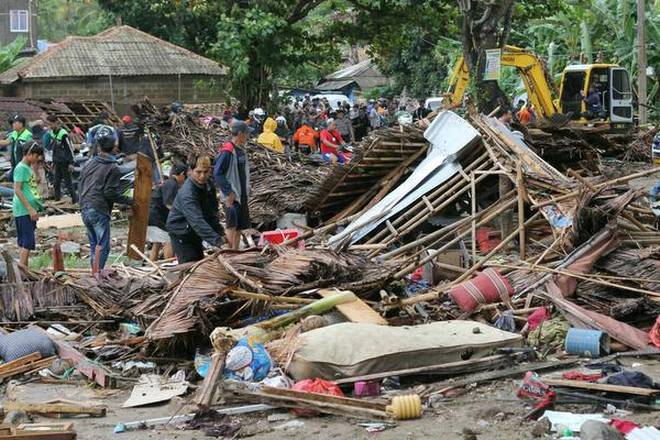A tsunami killed at least 222 people and injured hundreds on the Indonesian islands of Java and Sumatra following an underwater landslide believed caused by the erupting Anak Krakatau volcano, officials and media said on Sunday.
Hundreds of homes and other buildings were “heavily damaged” when the tsunami struck, almost without warning, along the rim of the Sunda Strait late on Saturday, Sutopo Purwo Nugroho, spokesman for the disaster mitigation agency, said.
Thousands of residents were forced to evacuate to higher ground. By 1040 GMT, the disaster agency had raised the death toll to 222 from 168, with 843 injured and 28 missing.
TV images showed the seconds when the tsunami hit the beach and residential areas in Pandeglang on Java island, dragging with it victims, debris, and large chunks of wood and metal.
Coastal residents reported not seeing or feeling any warning signs, such as receding water or an earthquake, before waves of 2-3 metres (6-10 feet) washed ashore, according to media.
Authorities said a warning siren went off in some areas.
The timing of the tsunami, over the Christmas holiday season, evoked memories of the Indian Ocean tsunami triggered by an earthquake on Dec. 26 in 2004, which killed 226,000 people in 13 countries, including more than 120,000 in Indonesia.
Oystein Lund Andersen, a Norwegian holidaymaker, was in Anyer town with his family when Saturday’s tsunami struck.
“I had to run, as the wave passed the beach and landed 15-20 metres inland. Next wave entered the hotel area where I was staying and downed cars on the road behind it,” he said on Facebook. “Managed to evacuate with my family to higher ground through forest paths and villages, where we are taken care of by the locals.”
“WASHED AWAY”
“The water washed away the stage which was located very close to the sea,” the band said in a statement. “The water rose and dragged away everyone at the location. We have lost loved ones, including our bassist and manager … and others are missing.”
Police officers rescued a young boy who was trapped in a car buried under fallen trees and rubble, according to a video of his rescue posted on Twitter by the Indonesian National Police, who did not give any information as to the boy’s identity.
Officials were trying to determine the exact cause of the disaster.
Anak Krakatau, an active volcano roughly halfway between Java and Sumatra, has been spewing ash and lava for months. It erupted again just after 9 p.m. on Saturday and the tsunami struck at around 9.30 p.m., according to BMKG.
The tsunami was caused by “an undersea landslide resulting from volcanic activity on Anak Krakatau” and was exacerbated by abnormally high tide because of the full moon, Nugroho said.
Ben van der Pluijm, an earthquake geologist and a professor in the University of Michigan, said the tsunami may have been caused by a “partial collapse” of Anak Krakatau.
“Instability of the slope of an active volcano can create a rock slide that moves a large volume of water, creating local tsunami waves that can be very powerful. This is like suddenly dropping a bag of sand in a tub filled with water,” he said.
The eruption of Krakatau, previously known as Krakatoa, in 1883 killed more than 36,000 people in a series of tsunamis.
Anak Krakatau is the island that emerged from the area once occupied by Krakatau, which was destroyed in 1883. It first appeared in 1927 and has been growing ever since.
Neighbouring Malaysia and Australia both said they were ready to provide assistance if needed.













